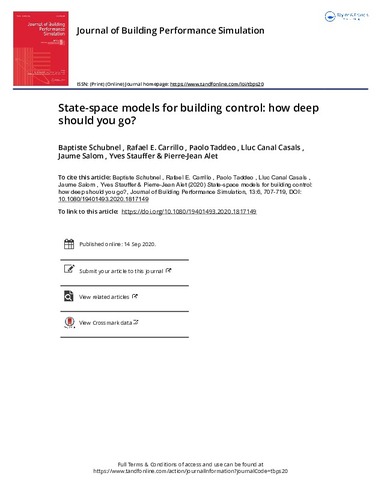Mostra el registre d'ítem simple
State-space models for building control: how deep should you go?
| dc.contributor.author | Schubnel, Baptiste |
| dc.contributor.author | Carrillo, Rafael E. |
| dc.contributor.author | Taddeo, Paolo |
| dc.contributor.author | Canals Casals, Lluc |
| dc.contributor.author | Salom, Jaume |
| dc.contributor.author | Stauffer, Yves |
| dc.contributor.other | Universitat Politècnica de Catalunya. Departament d'Enginyeria de Projectes i de la Construcció |
| dc.date.accessioned | 2021-03-08T08:34:06Z |
| dc.date.available | 2021-03-08T08:34:06Z |
| dc.date.issued | 2020-09-14 |
| dc.identifier.citation | Schubnel, B. [et al.]. State-space models for building control: how deep should you go? "Journal of Building Performance Simulation", 14 Setembre 2020, vol. 13, núm. 6, p. 707-719. |
| dc.identifier.issn | 1940-1493 |
| dc.identifier.uri | http://hdl.handle.net/2117/341069 |
| dc.description.abstract | Power consumption in buildings show nonlinear behaviours that linear models cannot capture, whereas recurrent neural networks (RNNs) can. This ability makes RNNs attractive alternatives for the model-predictive control (MPC) of buildings. However, RNNs are nonlinear and non-smooth functions which makes their use challenging in optimization problems. Therefore, this work systematically investigates whether using RNNs for building control provides net gains in MPC. It compares over 2 months of simulated operation the representation power and control performance of two architectures: an RNN architecture and a linear state-space (LSS) model with a nonlinear regressor to estimate energy consumption. The results show that RNNs yield an identification error 69% lower than LSS, but the LSS models yield control laws that achieve 10% lower objective function with a computational time three times lower than the RNNs. Thus, on balance, well-designed LSS models with nonlinear regressors are best in most cases of MPC. |
| dc.format.extent | 13 p. |
| dc.language.iso | eng |
| dc.rights | Attribution-NonCommercial-NoDerivs 3.0 Spain |
| dc.rights.uri | http://creativecommons.org/licenses/by-nc-nd/3.0/es/ |
| dc.subject | Àrees temàtiques de la UPC::Energies |
| dc.subject.lcsh | Predictive control |
| dc.subject.lcsh | Neural networks (Computer science) |
| dc.subject.other | Building modelling |
| dc.subject.other | Model predictive control |
| dc.subject.other | Linear state-space models |
| dc.subject.other | Neural networks |
| dc.subject.other | Optimization |
| dc.title | State-space models for building control: how deep should you go? |
| dc.type | Article |
| dc.subject.lemac | Control predictiu |
| dc.subject.lemac | Xarxes neuronals (Informàtica) |
| dc.subject.lemac | Edificis -- Instal·lacions -- Control automàtic |
| dc.contributor.group | Universitat Politècnica de Catalunya. GIIP - Grup de Recerca en Enginyeria de Projectes: Disseny i Sostenibilitat |
| dc.identifier.doi | 10.1080/19401493.2020.1817149 |
| dc.description.peerreviewed | Peer Reviewed |
| dc.relation.publisherversion | https://www.tandfonline.com/doi/full/10.1080/19401493.2020.1817149 |
| dc.rights.access | Open Access |
| local.identifier.drac | 29291459 |
| dc.description.version | Postprint (published version) |
| dc.relation.projectid | info:eu-repo/grantAgreement/EC/H2020/731211/EU/SmArt BI-directional multi eNergy gAteway/SABINA |
| local.citation.author | Schubnel, B.; Carrillo, R. E.; Taddeo, P.; Canals Casals, L.; Salom, J.; Stauffer, Y. |
| local.citation.publicationName | Journal of Building Performance Simulation |
| local.citation.volume | 13 |
| local.citation.number | 6 |
| local.citation.startingPage | 707 |
| local.citation.endingPage | 719 |
Fitxers d'aquest items
Aquest ítem apareix a les col·leccions següents
-
Articles de revista [360]


